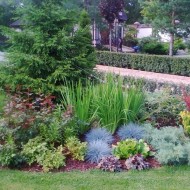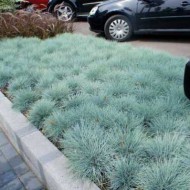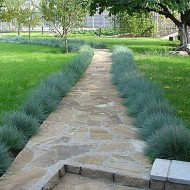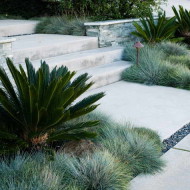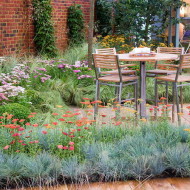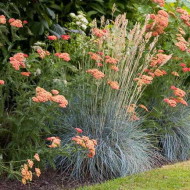We grow gray fescue in the country: from planting to garden decor
Content
Description of gray fescue
Blue fescue (also called gray fescue) is a perennial herb that reaches half a meter in height. It has a spherical shape and gray needle-like leaves. Some varieties are distinguished by foliage, the color of which resembles lapis lazuli.
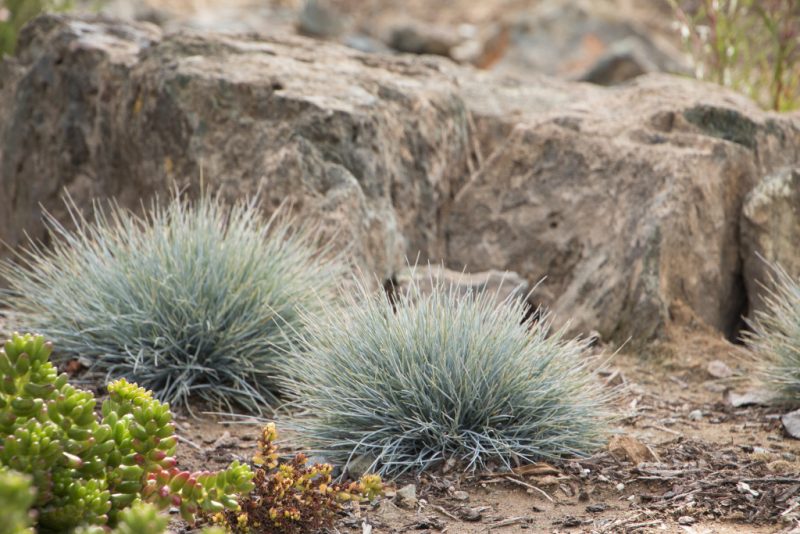
The culture retains its attractive appearance even during the cold season. Flowering begins in summer. Forms tall, panicle-shaped inflorescences that can be cut to avoid depleting the grass.
Recommended varieties for the garden
At your summer cottage, you can plant the following varieties of fescue:
- Glacial Titmouse. The height of the titmouse stems is only thirty centimeters, and the pillow of leaves is even lower. The inflorescences fit tightly to each other, so they seem massive.
- Gaultier. Festuca gautieri is a low plant with a sod of bright green leaves, which is about ten centimeters high. The pillow of this variety is so dense that it looks artificial.
- Filiform. This variety has a loose structure, the length of the leaves is fifteen centimeters. Peduncles grow up to thirty centimeters and have loose panicles that adorn the plant.
- Sheep. It has bristly greenery, on which hemispherical bumps are formed. The leaves are tough, reaching ten centimeters in length. Panicles have spikelets of complex shape with drooping structure.
Video "Growing gray fescue"
After watching this video, you will know how to grow a perennial from seeds.
Secrets of planting and caring for fescue
Fescue takes root quite quickly, and after the first shoots appear, it needs the same care as the lawn. The gardener needs to control soil moisture, top dressing, and also divide the plant a couple of times a year.
Comfortable growing conditions
Fescue loves warmth. To grow the plant successfully, choose a well-lit area of the garden where the sun will warm all year round. If you plant a crop in a darkened place, the shade of its leaves will not be bluish. There are no special requirements for the soil, so the grass will grow even on dry ground. However, do not plant fescue in wet areas and soils with a high nutrient value, as growth may slow down.
There is an opinion that the most spreading fescue grow on stony ground, so experts advise summer residents to plant a plant in just such a soil.
Growing from seeds
Since planting and caring for a plant does not require special knowledge and skills, every novice gardener can start growing this crop from seeds. This procedure should be carried out at the end of autumn or spring. Form a planting hole, place no more than four seeds in it. The distance between the grooves should be at least fifteen centimeters.Sprinkle soil over the holes and water thoroughly. The first shoots will appear in fourteen days. Loosen the soil regularly and water it occasionally.
Reproduction by seedlings
If you want to get young seedlings as early as possible, grow them through seedlings. Sowing is carried out in early spring. In this case, it is better not to cover the seeds with earth. Moisten the soil with water from a spray bottle, and the seeds will sink to the desired depth by themselves. To preserve the moisture content of the soil, cover it with a film, creating a kind of greenhouse. Room temperature is enough for the seeds to germinate in a couple of weeks. Seedlings should be watered carefully and infrequently to prevent decay.
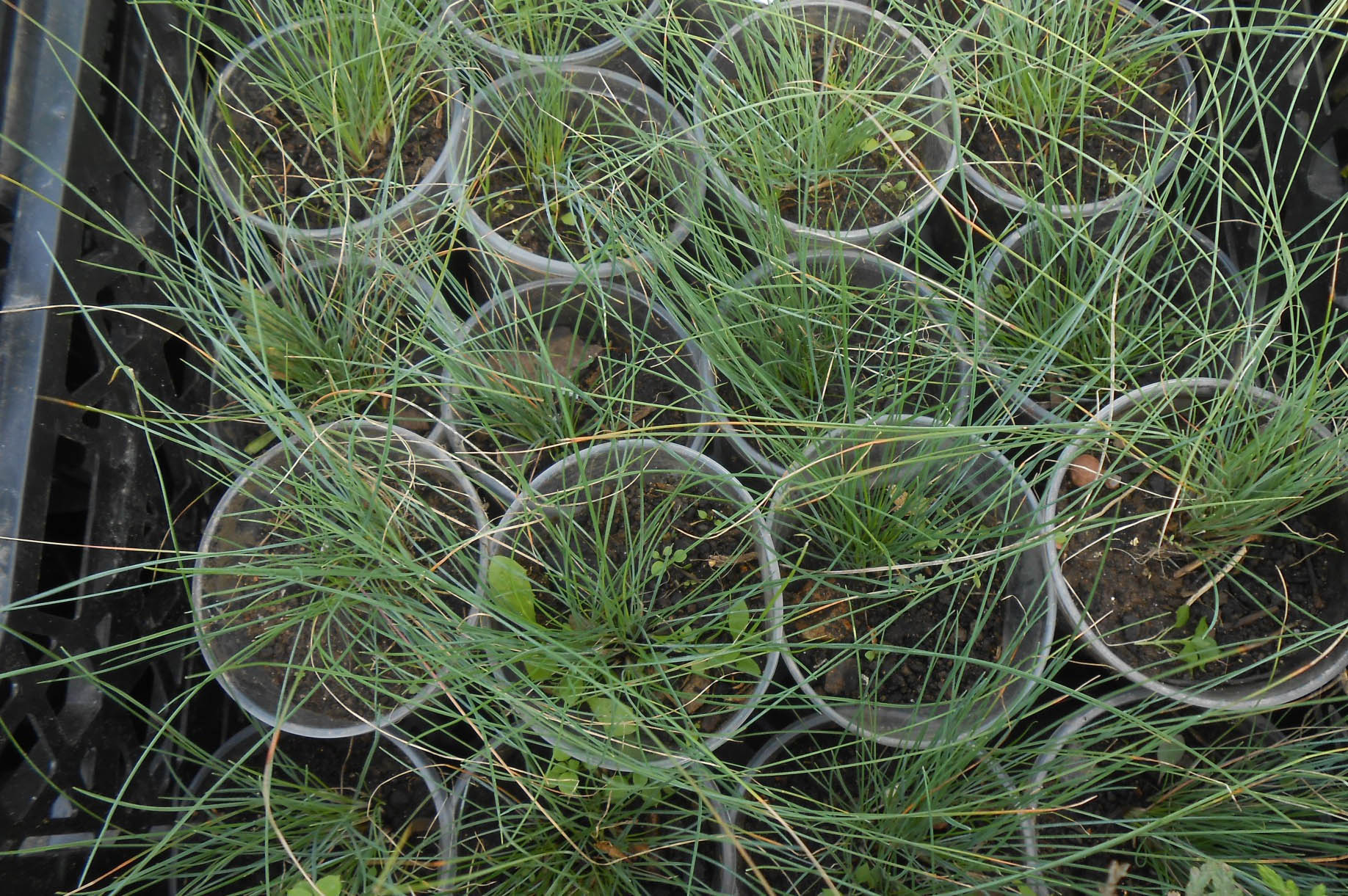
Reproduction by dividing the bush
This method is used to strengthen cereals. To do this, you need to dig out the bushes from the ground for the winter and place them in a box or bucket, keep them in conditions of maximum illumination. In the spring, the bush is divided and planted.
Transplant and rejuvenation
Fescue needs constant rejuvenation, because after a couple of years of life, its sods dry out and degenerate.
Wintering culture
In cold conditions, this plant feels good, tolerates frost persistently. In case of freezing, it quickly recovers without losing its decorative qualities. If you choose the optimal conditions for protection from cold and waterlogging for fescue, it will not need shelter for the winter.

Diseases and pests
This culture is practically not affected by diseases, but due to an excess of moisture or fertilizers, anthracnose or powdery mildew can develop. At the first signs of these ailments, the bushes are treated with the "Skor" agent.
No pests, except for the spider mite, are not terrible for the plant. The tick can attack during the dry season. You need to get rid of it immediately so that the plant does not disappear.
Gray fescue in landscape design
All types of this culture are harmoniously combined with other plants and have a spectacular appearance. Landscape designers advise growing fescue next to conifers, barberries, small spreading shrubs and euonymus. Fescue fits perfectly into rocky landscapes and gets along well with ground cover plants. Plant drought-resistant crops nearby: sedum, purslane, sword belt, stachis, etc.
- Mixed type mixborder
- Monoclumba
- Garden path decoration
- Decorating steps
- Recreation area decoration
- Group landing
As you can see, this plant can be planted even by novice gardeners, since it is unpretentious to grow and multiplies easily. This decorative grass is not afraid of pests and diseases, and its original needle-like leaves will be an excellent decoration for the garden.

